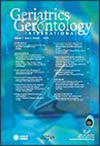Diagnostic accuracy analysis of SARC-F, its modified versions and the Quality of Life in Sarcopenia questionnaire in screening for sarcopenia in nursing home residents
Abstract
Aim
Sarcopenia, which is among the most important geriatric syndromes, is also a public health challenge. This study evaluated the performance of the SARC-F, its modified versions and the Quality of Life in Sarcopenia (SarQoL) in screening for sarcopenia.
Methods
In the diagnostic accuracy study carried out with a total of 195 nursing home residents, sarcopenia was evaluated according to the European Working Group on Sarcopenia in Older Persons 2 algorithm. For SARC-CalFs, the calf circumference standard and its population-specific reference (31 cm, 32/33 cm, respectively) were used, whereas for SARC + elderly and body mass index information, age (>75 years) and body mass index (<21 kg/m2) were used. Screening test performance was evaluated with receiver operating characteristic analysis, and the optimal cut-off points were determined according to the Youden index.
Results
The prevalence of sarcopenia was 33.8%. Although SarQoL and SARC-CalF scores were lower in individuals with sarcopenia, standard SARC-F and SARC-F + elderly and body mass index information scores were not different. SARC-F had the poorest screening performance, whereas the SarQoL scale had the best screening performance (area under the curve 0.502 vs 0.787). SARC-CalF (32/33 cm) had the best performance among the modified versions of SARC-F. The optimal cut-off point for SarQoL was <64.56, and its sensitivity in sarcopenia screening was 74.24% (95% CI 62.0–84.2) and its specificity was 79.07% (95% CI 71.0–85.7). All the modified versions of SARC-CalF had higher sensitivity and area under the curve compared with SARC-F.
Conclusions
SarQoL screening performance might be conducive to providing clinical discrimination in a nursing home sample. Further research is needed for the use of SarQoL as a potential sarcopenia screening strategy. Additionally, SARC-CalFs, especially the population-specific SARC-CalF (32/33 cm), might improve screening performance compared with standard SARC-F. Geriatr Gerontol Int 2024; 24: 1335–1342.

 求助内容:
求助内容: 应助结果提醒方式:
应助结果提醒方式:


